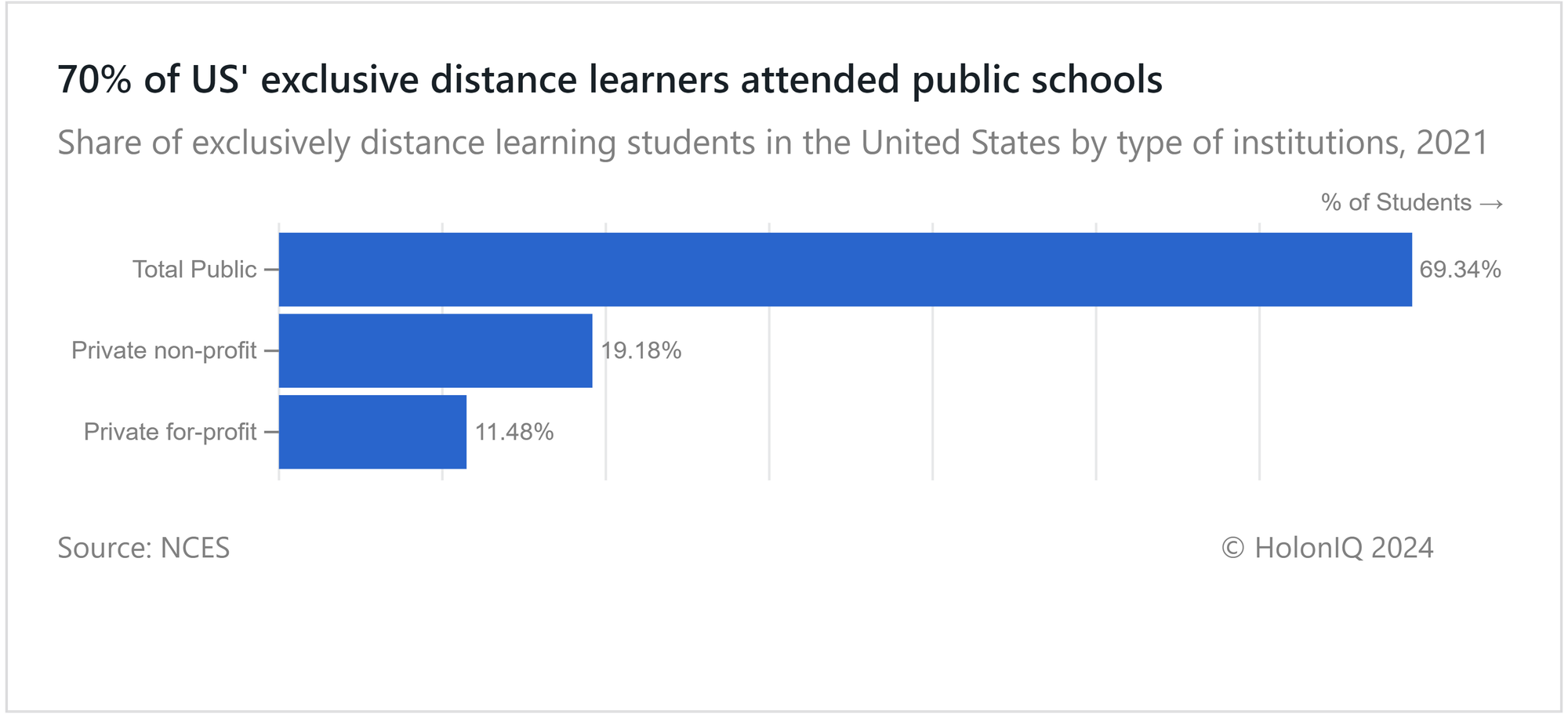🌞 China 2x EU Solar. 70% Public Distance Learners. Diabetes Mortality.
Chart of the Day #81 looks at Distance Learning, Solar Energy Capacity, and Diabetes and Kidney Diseases.
South Korea is strategizing a space-based solar power project aimed at deploying a satellite capable of generating 120GW of power. This translates to approximately 1TWh of electricity annually, which is almost double the nation’s electricity consumption in 2021. Surgeons successfully performed the first-ever organ transplant on a patient with a mechanical heart pump. The patient, facing heart and kidney failure, received a mechanical heart and a gene-edited pig kidney.
Today's Topics
🎓 Distance Learning. US public institutions enrolled 70% of exclusive distance learners
☀️ Solar Power. China leads in solar PV, 2x the EU's capacity
💉 Kidney Disease. Women exhibit higher rates of diabetic kidney disease
For unlimited access to over one million charts, request a demo.
🎓 US Public Institutions Enrolled 70% of Exclusive Distance Learners

Out of 18.7 million students enrolled in degree-granting postsecondary institutions in the United States in 2021, 60% opted for distance education courses. Among the exclusive distance learning students, 69.3% were enrolled in public institutions, with the remaining 30.7% in private ones. As schools reopened in 2021, traditional degree-seeking students returned to in-person learning, prompting universities and students to prioritize in-person learning experiences, while the overall growth of online education continued.
Distance learning reduced overall costs for students by eliminating travel and lodging expenses, making education more convenient and accessible to a wider range of learners. Conversely, online learning can also have drawbacks, such as decreased student engagement and challenges with social interaction. As the pandemic situation improved, students who struggled with remote learning chose to return to traditional in-person classes marking a decline of 3 million distance learning students compared to fall 2020.
🌞 China Leads in Solar PV, 2x The EU's Capacity
In 2022, China led global solar photovoltaic (PV) capacity, achieving a cumulative capacity of 414.5 GW, more than twice that of the European Union's. The EU made significant strides, increasing its solar power generation capacity by 25% from 167.5 GW in 2021 to 208.9 GW in 2022, with Germany leading in solar installations. Japan, however, has faced challenges in expanding its solar capacity due to geographic constraints like its mountainous terrain, susceptibility to natural disasters, and high population density, which limits the available space for large-scale solar installations.
In 2023, China further increased its solar power capacity by 55.2%, adding over 216 GW, supported by government subsidies, tax incentives, and supportive policies aimed at promoting solar energy growth. Meanwhile, India has made advances in gaining more solar investments, securing $3.8 billion in foreign direct investment over the past three years through September 2023. Despite this progress, India's renewable energy projects faced challenges in 2023, including delays and uncertainties stemming from policy decisions, political factors, and supply chain disruptions. In the European Union, Germany and the Netherlands have been key players in solar development. However, a shifting focus towards wind energy indicates that future solar capacity expansions in these countries may be limited.
🧁 Women Exhibit Higher Rates of Diabetic Kidney Disease
In Europe, the number of women dying from chronic kidney disease (CKD) is increasing at a faster rate than men, due to the prevalence of type 2 diabetes. In 2019, men experienced 3.8 deaths per 100,000 of the population from CKD, marking a 17.4% increase since 2010. In comparison, there was a 25% increase in deaths of females recorded since 2010.
CKD is common among people with diabetes, with approximately 1 in 3 adults with diabetes also having CKD. As CKD often develops slowly and with minimal symptoms, many patients fail to get diagnosed until they reach advanced stages requiring dialysis or kidney transplants. This delayed diagnosis may have contributed to the escalating mortality rates observed among both genders. Many individuals with diabetes also develop high blood pressure (HBP), affecting approximately 1 in 5 diabetes patients. HBP is also the second leading cause of kidney failure, as it has the potential to exacerbate kidney damage by causing blood vessels to constrict, eventually weakening them and hindering filtration.
Like getting this newsletter? For unlimited access to over one million charts, request a demo.
Thank you for reading. Have a great week ahead!
Have some feedback or want to sponsor this newsletter? Let us know at hello@holoniq.com
